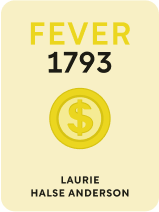

This article is an excerpt from the Shortform book guide to "Fever 1793" by Laurie Halse Anderson. Shortform has the world's best summaries and analyses of books you should be reading.
Like this article? Sign up for a free trial here .
What happened when Lucille Cook contracted yellow fever? What were her symptoms? How did this affect Matilda’s life?
In Fever 1793, Matilda’s mother, Lucille Cook, got yellow fever. For a while, Matilda tried to care for Lucille but she deteriorated quickly. When it seemed like Lucille might die from the disease, she forced Matilda to leave to protect her from getting infected as well.
Keep reading to learn about Lucille Cook’s battle with yellow fever and how it changed Matilda’s life.
Lucille Cook Gets Yellow Fever
Matilda and Grandpa walked silently back home. She counted the number of days until the first frost, which would destroy the fever: 28 at the minimum. Suddenly, going to the Ludington’s didn’t seem like such a bad idea.
A dirty man pushed a wheelbarrow past them on the sidewalk. A human arm dangled over the side. Grandpa was livid that this man was carting bodies in the good part of town during the day. But when the man stopped in front of the coffeehouse, Matilda felt her throat tighten. She ran toward the man, arriving just as he dumped a woman’s body on the sidewalk. It was Matilda’s mother, Lucille Cook.
A Family in Jeopardy
Matilda’s life was about to change in ways she never could have imagined. Grandpa checked Lucille’s pulse. She was alive but unconscious. He and Matilda carried her inside and up to the bedroom. Eliza screamed at the sight of Mrs. Cook unwell.
Grandpa assured the ladies that Lucille had merely passed out from the heat and exhaustion. A good rest should do the trick, but Matilda wasn’t so sure. Lucille opened her eyes briefly. Matilda waited for her to jump up and start ordering everyone around, but she didn’t. Instead, she told Matilda to take care of things downstairs while she rested. Her body shook with chills.
The day was a disaster. Matilda spilled coffee and tea everywhere, Eliza lost focus and burned food, and the patrons were tense and rowdy. When the day was finally over, only Grandpa and another man remained. His name was Mr. Rowley, and Grandpa told him about Lucille’s condition. Although he wasn’t a real doctor, Mr. Rowley did have some medical knowledge and offered to help. The real doctors were all down at the waterfront, where Eliza heard bodies were piling up like wood.
Matilda didn’t like Mr. Rowley. His hands and face were grimy, and he smelled like booze. Rowley examined Lucille and said it wasn’t yellow fever, just a normal autumnal fever. There was nothing to worry about. Eliza protested. The great Dr. Rush said that yellow fever was spreading through the city, she told him. But Rowley cautioned against such claims. He said one family had thrown the elderly matriarch out on the street when another doctor diagnosed her with yellow fever. She died, and it turned out to be a false diagnosis. Rowley collected his fee and was on his way. Grandpa William was triumphant at the news. He knew he’d been right about the misguided hysteria all along.
The Fever Takes Hold
Despite Rowley’s claims, Lucille was very ill. She needed round-the-clock care to get better. Eliza and Matilda bathed her every four hours and changed the bedding each time. Matilda was mortified at having to bathe her mother, but Eliza couldn’t do it alone. They also gave her different teas that Rowley had prescribed, but nothing seemed to work.
Lucille deteriorated quickly. The fever grew and warped her mind, causing her to weep and call out for her husband. The chills were so bad, her teeth chattered. Her blue eyes showed streaks of red and yellow. Grandpa stayed with Mr. Carris to avoid catching something, and Eliza had to tend to her brother’s family in the evening. Matilda was on her own.
At night, Matilda sat vigil by her mother’s side. She looked into Lucille’s contorted face and wondered if her mother had ever been happy. Maybe death was a way she could be released from all the struggles she’d faced. Matilda grew emotional thinking of all the things her mother had tried to teach her that she always ignored. She prayed, read Psalms, and drifted to sleep.
Matilda woke suddenly to the sound of her mother getting sick. Lucille was vomiting blood, and her eyes rolled back in their sockets. Matilda screamed for help, then remembered she was alone. Lucille opened her eyes and looked at her daughter. She could barely form the words to tell Matilda to leave the room. A pungent black substance spewed from her mouth. Matilda tried to clean the mess. She wanted to be there for her mother, but Lucille screamed for her to leave. She didn’t want her daughter infected with whatever was trying to kill her.
Into the Unknown
Four days later, the Cooks received an unpleasant surprise that would force them apart. Lucille was alive but pallid and weak. Eliza and Grandpa had tracked down a real doctor, Dr. Kerr, to examine Lucille. He was a small Scottish man who carried a little black medical bag. While he examined Lucille, he asked about her condition during the night. Matilda rushed to explain that she’d continued to bathe her every four hours and give her the teas from Rowley. She thought a simple case of autumnal fever would have cleared up by now.
When Dr. Kerr learned about Rowley’s diagnosis, he called him a charlatan and said there was no question in his mind that Lucille had yellow fever. Matilda couldn’t breathe. How could her mother be dying of a stupid fever? Her mother had cooked a feast for the whole family hours after giving birth and fended off British soldiers while her husband was fighting in the war. This woman couldn’t die so easily. She wouldn’t.
Dr. Kerr cut a vein on Lucille’s arm and collected the blood in a basin. When it was full, he filled up a second one. He took 10 ounces that day and would be back to take 10 more tomorrow. He prescribed medications to evacuate her stomach and bowels. He said Lucille was strong and could make it through with proper care.
After the bloodletting, Lucille roused and ordered Matilda out. Dr. Kerr escorted Matilda downstairs and gave Grandpa and Eliza the unhappy news that she should be sent to the country. People were panicking, he said. It wasn’t safe for a young girl to be in the city right now. Matilda threw a fit and refused to leave, but everyone thought it was best. A plan was made, and Grandpa left to secure a carriage for the journey.
After things settled down, Eliza remembered a package that had come for Matilda. It was a painting of flowers in a vase on a wooden board. The card attached was from Nathaniel Benson. He was locked in the Peale’s house with the family for protection. He wished Matilda safety and good health and promised they’d reunite when the plague was over.
The next morning, Grandpa packed their trunks and food pantry into a carriage belonging to a local farmer. He would accompany her on her journey to the country. When it was time to leave, he put on his regiment uniform and saluted Matilda. He clicked his heels together to bring some levity to the situation. Eliza and Matilda said an emotional goodbye, promising to see each other soon. Matilda climbed into the carriage next to her grandfather. The carriage pulled away. Her journey into an unknown future began.

———End of Preview———
Like what you just read? Read the rest of the world's best book summary and analysis of Laurie Halse Anderson's "Fever 1793" at Shortform .
Here's what you'll find in our full Fever 1793 summary :
- What the yellow fever epidemic in 1793 in Philadelphia looked like
- How this epidemic exposed the vulnerability of everyone, including the wealthy
- How an epidemic can impact a young person






